107 books about Boston and 7
start with C
107 books about Boston and 7
107 books about Boston
7 start with C start with C
7 start with C start with C
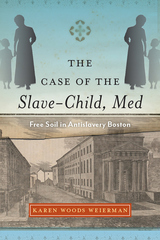
The Case of the Slave-Child, Med
Free Soil in Antislavery Boston
Karen Woods Weierman
University of Massachusetts Press, 2019
In 1836, an enslaved six-year-old girl named Med was brought to Boston by a woman from New Orleans who claimed her as property. Learning of the girl's arrival in the city, the Boston Female Anti-Slavery Society (BFASS) waged a legal fight to secure her freedom and affirm the free soil of Massachusetts. While Chief Justice Lemuel Shaw ruled quite narrowly in the case that enslaved people brought to Massachusetts could not be held against their will, BFASS claimed a broad victory for the abolitionist cause, and Med was released to the care of a local institution. When she died two years later, celebration quickly turned to silence, and her story was soon forgotten. As a result, Commonwealth v. Aves is little known outside of legal scholarship. In this book, Karen Woods Weierman complicates Boston's identity as the birthplace of abolition and the cradle of liberty, and restores Med to her rightful place in antislavery history by situating her story in the context of other writings on slavery, childhood, and the law.
[more]
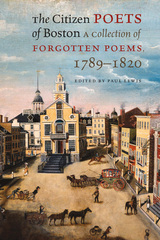
The Citizen Poets of Boston
A Collection of Forgotten Poems, 1789–1820
Edited by Paul Lewis
University Press of New England, 2016
Welcome to Boston in the early years of the republic. Prepare to journey by stagecoach with a young man moving to the “bustling city”; stop by a tavern for food, drink, and conversation; eavesdrop on clerks and customers in a dry-goods shop; get stuck in what might have been Boston’s first traffic jam; and enjoy arch comments about spouses, doctors, lawyers, politicians, and poets. As Paul Lewis and his students at Boston College reveal, regional vernacular poetry—largely overlooked or deemed of little or no artistic value—provides access to the culture and daily life of the city. Selected from over 4,500 poems published during the early national period, the works presented here, mostly anonymous, will carry you back to Old Boston to hear the voices of its long-forgotten citizen poets. A rich collection of lost poetry that will beguile locals and visitors alike.
[more]
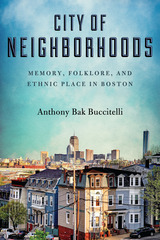
City of Neighborhoods
Memory, Folklore, and Ethnic Place in Boston
Anthony Bak Buccitelli
University of Wisconsin Press, 2016
East Boston has long been known as an Italian neighborhood and Southie as an Irish one, while nearby North Quincy has seen in recent decades an influx of Chinese Americans and immigrants. Such urban spaces in America can become intimately intertwined with ethnic identities (Little Italy, Greektown, Chinatown, Little Havana). Yet local residents often readily acknowledge an underlying diversity—both historically and as a result of more recent changes—that complicates such stereotypes.
Digging into the ever-shifting terrain of American ethnicity and urban spaces, Anthony Bak Buccitelli investigates folk practices, social memory, and local histories in three Boston-area neighborhoods. He looks at the ways locals represent their neighborhoods and themselves via events, symbols, stories, and landmarks, from the shamrock to the Chinese flag, whether the St. Patrick’s Day parade in Southie or the Columbus Day parade in East Boston, from urban graffiti and websites to the Dorchester Heights Monument. City of Neighborhoods exposes the processes of selection and emphasis that produce, sustain, challenge, and change understandings of urban spaces as ethnic places.
Honorable mention, Wayland Hand Prize for Folklore and History, American Folklore Society
Digging into the ever-shifting terrain of American ethnicity and urban spaces, Anthony Bak Buccitelli investigates folk practices, social memory, and local histories in three Boston-area neighborhoods. He looks at the ways locals represent their neighborhoods and themselves via events, symbols, stories, and landmarks, from the shamrock to the Chinese flag, whether the St. Patrick’s Day parade in Southie or the Columbus Day parade in East Boston, from urban graffiti and websites to the Dorchester Heights Monument. City of Neighborhoods exposes the processes of selection and emphasis that produce, sustain, challenge, and change understandings of urban spaces as ethnic places.
Honorable mention, Wayland Hand Prize for Folklore and History, American Folklore Society
[more]
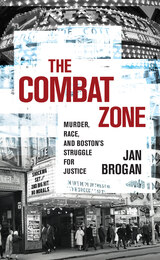
The Combat Zone
Murder, Race, and Boston's Struggle for Justice
Jan Brogan
University of Massachusetts Press, 2021
Shortlisted for the 2021 Agatha Award for Best Non-Fiction and the 2022 Anthony Award for Best Critical or Nonfiction Work
At the end of the 1976 football season, more than forty Harvard athletes went to Boston's Combat Zone to celebrate. In the city's adult entertainment district, drugs and prostitution ran rampant, violent crime was commonplace, and corrupt police turned the other way. At the end of the night, Italian American star athlete Andy Puopolo, raised in the city's North End, was murdered in a stabbing. Three African American men were accused of the crime. His murder made national news and led to the eventual demise of the city's red-light district.
Starting with this brutal murder, The Combat Zone tells the story of the Puopolo family's struggle with both a devastating loss and a criminal justice system that produced two trials with opposing verdicts, all within the context of a racially divided Boston. Brogan traces the contentious relationship between Boston’s segregated neighborhoods during the busing crisis; shines a light on a court system that allowed lawyers to strike potential jurors based purely on their racial or ethnic identity; and lays bare the deep-seated corruption within the police department and throughout the Combat Zone. What emerges is a fascinating snapshot of the city at a transitional moment in its recent past.
At the end of the 1976 football season, more than forty Harvard athletes went to Boston's Combat Zone to celebrate. In the city's adult entertainment district, drugs and prostitution ran rampant, violent crime was commonplace, and corrupt police turned the other way. At the end of the night, Italian American star athlete Andy Puopolo, raised in the city's North End, was murdered in a stabbing. Three African American men were accused of the crime. His murder made national news and led to the eventual demise of the city's red-light district.
Starting with this brutal murder, The Combat Zone tells the story of the Puopolo family's struggle with both a devastating loss and a criminal justice system that produced two trials with opposing verdicts, all within the context of a racially divided Boston. Brogan traces the contentious relationship between Boston’s segregated neighborhoods during the busing crisis; shines a light on a court system that allowed lawyers to strike potential jurors based purely on their racial or ethnic identity; and lays bare the deep-seated corruption within the police department and throughout the Combat Zone. What emerges is a fascinating snapshot of the city at a transitional moment in its recent past.
[more]
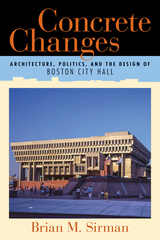
Concrete Changes
Architecture, Politics, and the Design of Boston City Hall
Brian M. Sirman
University of Massachusetts Press, 2018
From the 1950s to the end of the twentieth century, Boston transformed from a city in freefall into a thriving metropolis, as modern glass skyscrapers sprouted up in the midst of iconic brick rowhouses. After decades of corruption and graft, a new generation of politicians swept into office, seeking to revitalize Boston through large-scale urban renewal projects. The most important of these was a new city hall, which they hoped would project a bold vision of civic participation. The massive Brutalist building that was unveiled in 1962 stands apart—emblematic of the city's rebirth through avant-garde design.
And yet Boston City Hall frequently ranks among the country's ugliest buildings. Concrete Changes seeks to answer a common question for contemporary viewers: How did this happen? In a lively narrative filled with big personalities and newspaper accounts, Brian M. Sirman argues that this structure is more than a symbol of Boston's modernization; it acted as a catalyst for political, social, and economic change.
And yet Boston City Hall frequently ranks among the country's ugliest buildings. Concrete Changes seeks to answer a common question for contemporary viewers: How did this happen? In a lively narrative filled with big personalities and newspaper accounts, Brian M. Sirman argues that this structure is more than a symbol of Boston's modernization; it acted as a catalyst for political, social, and economic change.
[more]
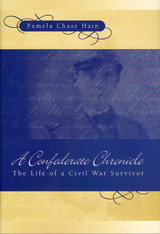
A Confederate Chronicle
The Life of a Civil War Survivor
Pamela Chase Hain
University of Missouri Press, 2005
A Confederate Chronicle presents the remarkable life of Thomas L. Wragg, who served in both the Confederate army and navy and endured incarceration as a prisoner of war. After the war, he undertook a series of jobs, eventually becoming a physician. In 1889, he died tragically at the hands of a man who mistakenly thought he was defending his family’s honor. Pamela Chase Hain uses Wragg’s letters home to his family, friends, and fiancée, as well as his naval notebook and newspaper articles, to give readers direct insight into his life and the lives of those around him.
The son of a respected Savannah physician, Wragg was born into a life of wealth and privilege. A nonconscripted soldier, he left home at eighteen to join the front lines in Virginia. From there, he sent letters home describing the maneuverings of General Joseph E. Johnston’s army in and around Harpers Ferry and Winchester, culminating with the Battle of Bull Run.
In the fall of 1862, Wragg joined the Confederate Navy and trained on the ironclad CSS Georgia before transferring to the CSS Atlanta. Hain uses the notebook that he kept during his training in ordnance and gunnery to provide a rare glimpse into the naval and artillery practices at the time. This notebook also provides evidence of a fledgling Confederate naval “school” prior to the one established on the James River on the CSS Patrick Henry.
The crew of the unfortunate Atlanta was captured on the ship’s maiden voyage, and evidence in the Wragg family papers suggests the capture was not the result of bad luck, as has been claimed. Wragg and the other officers were sent to Fort Warren Prison in Boston Harbor for fifteen months. Wragg’s POW letters reveal the isolation and sense of abandonment the prisoners felt as they waited in hopes of an exchange. The correspondence between Wragg and his fiancée, Josie, after the war illustrates not only the mores of nineteenth-century courtship but also the difficulty of adjustment that many Confederate war veterans faced.
Sadly, Wragg’s life was cut short after he became a successful doctor in Quincy, Florida. Cover-up and intrigue by influential citizens prevented Wragg’s wife from bringing the murderer to justice. A Confederate Chronicle offers an unprecedented look at how the Civil War affected the gentry class of the South. It gives readers a personal view into one man’s struggle with the chaos of life during and after the war, as well as into the struggles of the general society.
[more]
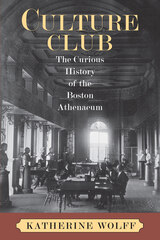
Culture Club
The Curious History of the Boston Athenaeum
Katherine Wolff
University of Massachusetts Press, 2009
Founded in 1807, the successor to a literary club called the Anthology Society, the Boston Athenaeum occupies an important place in the early history of American intellectual life. At first a repository for books, to which works of art were later added, the Athenaeum attracted over time a following that included such literary luminaries as Ralph Waldo Emerson and Henry James.
Yet from the outset, Katherine Wolff shows, the Boston Athenaeum was more than a library; it was also a breeding ground for evolving notions of cultural authority and American identity. Though governed by the Boston elite, who promoted it as a way of strengthening their own clout in the city, the early Athenaeum reflected conflicting and at times contradictory aims and motives on the part of its membership. On the one hand, by drawing on European aesthetic models to reinforce an exalted sense of mission, Athenaeum leaders sought to establish themselves as guardians of a nascent American culture. On the other, they struggled to balance their goals with their concerns about an increasingly democratic urban populace. As the Boston Athenaeum opened its doors to women as well as men outside its inner circle, it eventually began to define itself against a more accessible literary institution, the Boston Public Library.
Told through a series of provocative episodes and generously illustrated, Culture Club offers a more complete picture than previously available of the cultural politics behind the making of a quintessentially American institution.
Yet from the outset, Katherine Wolff shows, the Boston Athenaeum was more than a library; it was also a breeding ground for evolving notions of cultural authority and American identity. Though governed by the Boston elite, who promoted it as a way of strengthening their own clout in the city, the early Athenaeum reflected conflicting and at times contradictory aims and motives on the part of its membership. On the one hand, by drawing on European aesthetic models to reinforce an exalted sense of mission, Athenaeum leaders sought to establish themselves as guardians of a nascent American culture. On the other, they struggled to balance their goals with their concerns about an increasingly democratic urban populace. As the Boston Athenaeum opened its doors to women as well as men outside its inner circle, it eventually began to define itself against a more accessible literary institution, the Boston Public Library.
Told through a series of provocative episodes and generously illustrated, Culture Club offers a more complete picture than previously available of the cultural politics behind the making of a quintessentially American institution.
[more]
READERS
Browse our collection.
PUBLISHERS
See BiblioVault's publisher services.
STUDENT SERVICES
Files for college accessibility offices.
UChicago Accessibility Resources
home | accessibility | search | about | contact us
BiblioVault ® 2001 - 2024
The University of Chicago Press









